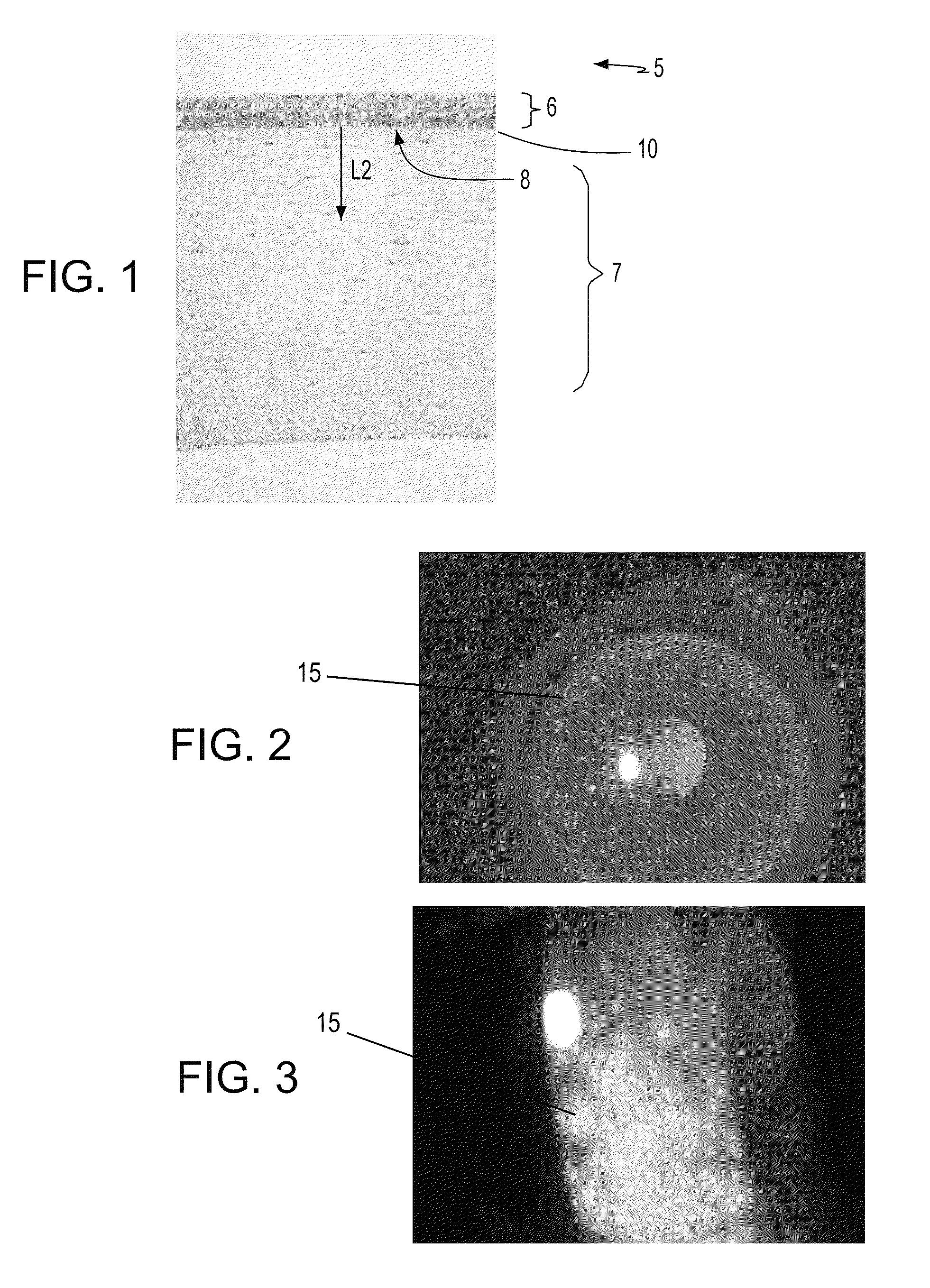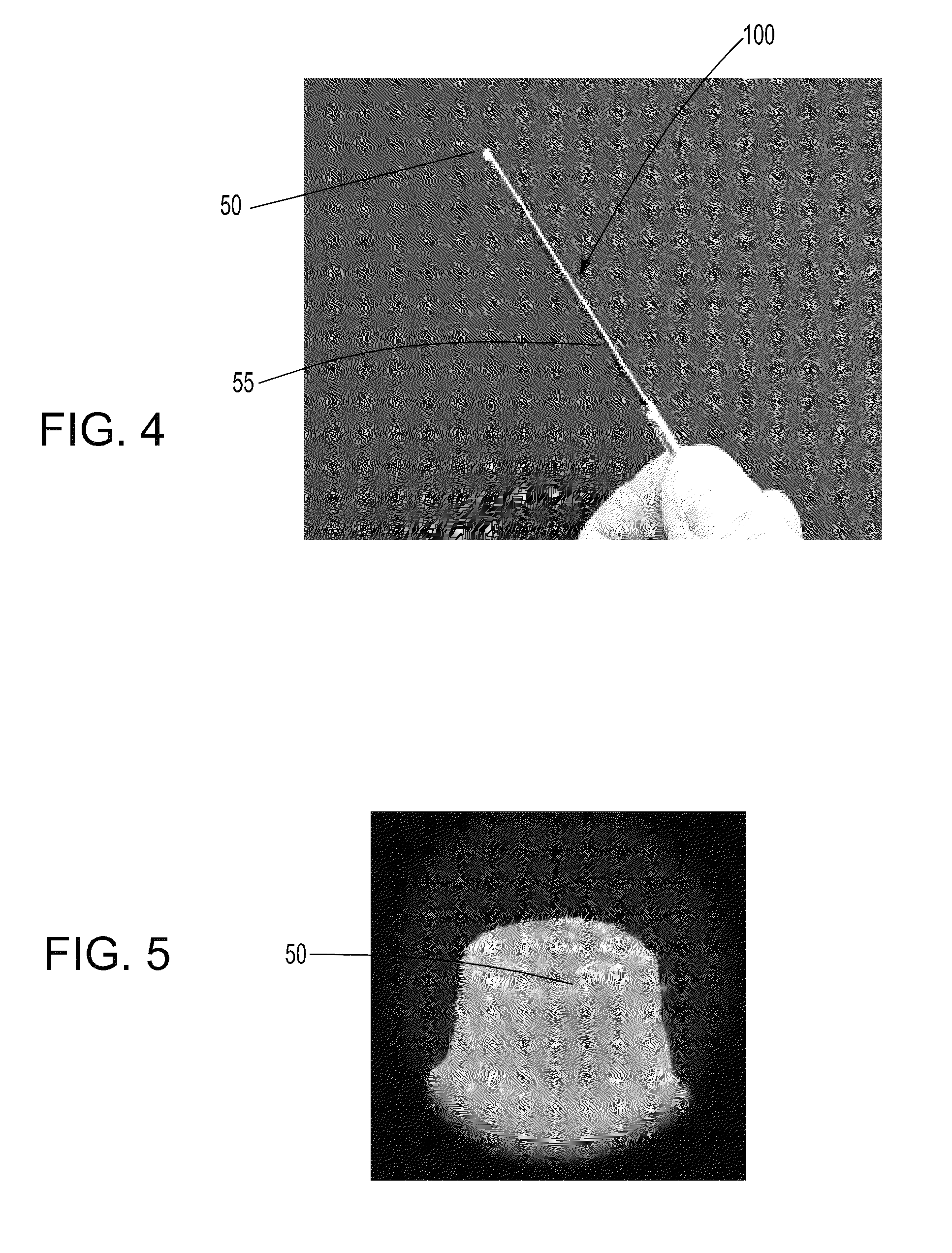Microfabricated instruments and methods to treat recurrent corneal erosion
a microfabricated instrument and corneal technology, applied in the field of surgical instruments, can solve the problems of reducing the corneal transparency of the area, defective epithelial cell attachment, and failure of basal epithelial to produce proper basement membrane complexes to attach bowman's layer and stroma, and achieve the effect of enhancing wound healing
Active Publication Date: 2013-11-26
UNIV OF TENNESSEE RES FOUND +1
View PDF23 Cites 2 Cited by
- Summary
- Abstract
- Description
- Claims
- Application Information
AI Technical Summary
Benefits of technology
[0024]In one embodiment, the treated surface includes an epithelial growth factor, wherein when the array glass micro-rods is contacted to a defect in an epithelium layer, the epithelial growth factor enhances wound healing and epithelial resurfacing in the defect in the epithelium layer.
[0027]In yet another embodiment, the treated surface includes at least one of an antibiotics or antiviral agent, wherein when the array of glass micro-rods is contacted to the cornea, the antibiotics or the antiviral agent promote healing of infectious lesions.
Problems solved by technology
Recurrent corneal erosions occur because there is a defect in the epithelial basement layer 6 and in hemidesmosome formation, resulting in defective epithelial cell attachment.
More specifically, the basal epithelial fail to produce proper basement membrane complexes to attach the Bowman's layer and stroma.
Unfortunately, the scaring induced by puncturing the Bowman's layer disrupts the alignment of the collagen fibers in the anterior stroma by inducing new collagen deposition, which reduces the corneal transparency of the areas in which the punctures are produced resulting in white focal scars.
In one embodiment, the plurality of punctures have a diameter that results in scaring that would not be visual with the naked eye, i.e., without optical enhancement, such as magnification.
Method used
the structure of the environmentally friendly knitted fabric provided by the present invention; figure 2 Flow chart of the yarn wrapping machine for environmentally friendly knitted fabrics and storage devices; image 3 Is the parameter map of the yarn covering machine
View moreImage
Smart Image Click on the blue labels to locate them in the text.
Smart ImageViewing Examples
Examples
Experimental program
Comparison scheme
Effect test
examples
[0101]FIGS. 10a and 10b depict an array of punctures 70 formed through a polyethylene sheet having a thickness on the order of 10 microns. FIG. 10a depicts a magnification of approximately 100×. FIG. 10b depicts a magnification of 430×. The array of glass micro-rods included a pitch of approximately 7 microns and each glass micro-rod had a height of approximately 12 microns.
the structure of the environmentally friendly knitted fabric provided by the present invention; figure 2 Flow chart of the yarn wrapping machine for environmentally friendly knitted fabrics and storage devices; image 3 Is the parameter map of the yarn covering machine
Login to View More PUM
 Login to View More
Login to View More Abstract
In one embodiment, the present invention provides a device and method for treating recurrent corneal erosion. In one embodiment, the method includes the steps of contacting an epithelium layer of a cornea with an array of glass micro-rods including a plurality of sharp features having a length that penetrates a Bowman's layer of the eye, wherein the plurality of sharp features of the array of glass micro-rods produces a plurality of punctures in the Bowman's layer of the eye that are of micro-scale or less. In another embodiment, the present invention provides a method and device for drug delivery. In one embodiment, the device includes an array of glass micro-rods, wherein at least one glass micro-rod of the array of glass micro-rods includes a sharp feature opposite a base of the array of glass micro-rods, wherein the sharp feature includes a treated surface for delivering a chemical compound to the eye.
Description
STATEMENT REGARDING FEDERALLY SPONSORED RESEARCH OR DEVELOPMENT[0001]This invention was made with Government support under Contract No. DE-AC05-00OR22725 awarded by the United States Department of Energy. The Government has certain rights in this invention.FIELD OF THE INVENTION[0002]The present invention in one embodiment relates to surgical instruments. In another embodiment, the present invention relates to a method of treating corneal erosions.BACKGROUND OF THE INVENTION[0003]Referring to FIG. 1, a corneal abrasion is an injury to the surface epithelium 6 of the cornea 5 that is superficial enough not to involve the basement membrane, i.e., Bowman's layer 10. It is typically due to mechanical trauma, but may also be associated with degenerative changes in the cornea and chronic edema. The defect is seen as superficial on a slit lamp and takes up fluorescence, shining green upon illumination with cobalt blue light. Treatment for uncomplicated abrasions is usually prophylactic ant...
Claims
the structure of the environmentally friendly knitted fabric provided by the present invention; figure 2 Flow chart of the yarn wrapping machine for environmentally friendly knitted fabrics and storage devices; image 3 Is the parameter map of the yarn covering machine
Login to View More Application Information
Patent Timeline
 Login to View More
Login to View More Patent Type & Authority Patents(United States)
IPC IPC(8): A61M5/158
CPCA61F9/007A61F9/0017A61B2017/320004
Inventor BRITTON, CHARLES L.D'URSO, BRIAN R.CHAUM, EDWARDSIMPSON, JOHN T.BABA, JUSTIN S.ERICSON, M. NANCEWARMACK, ROBERT J.
Owner UNIV OF TENNESSEE RES FOUND
Features
- R&D
- Intellectual Property
- Life Sciences
- Materials
- Tech Scout
Why Patsnap Eureka
- Unparalleled Data Quality
- Higher Quality Content
- 60% Fewer Hallucinations
Social media
Patsnap Eureka Blog
Learn More Browse by: Latest US Patents, China's latest patents, Technical Efficacy Thesaurus, Application Domain, Technology Topic, Popular Technical Reports.
© 2025 PatSnap. All rights reserved.Legal|Privacy policy|Modern Slavery Act Transparency Statement|Sitemap|About US| Contact US: help@patsnap.com



